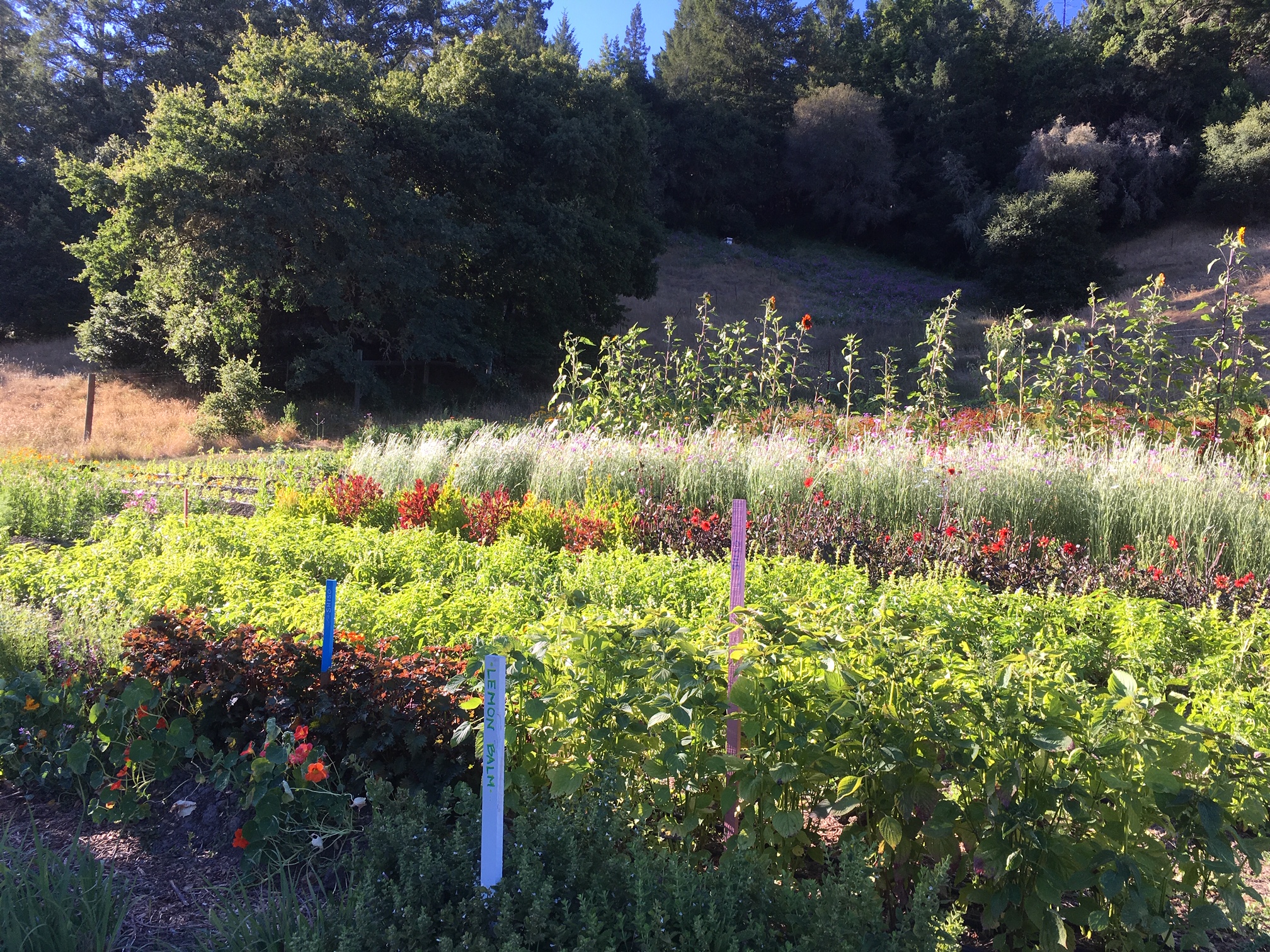THIS WEEK'S HARVEST
Rainbow Carrots, Fennel, Olympian Cucumbers, Lemon Cucumbers, Summer Squash and Zucchini, Slicing Tomatoes, Heirloom Tomatoes, Eggplant, Fresh Cabernet Onions, Creole Hardneck Garlic, Mustards & Arugula Salad Mix, Hearts-Aglow Lettuce Mix, Little Gem Lettuces, Red Butter Lettuce and Panisse Oak Leaf Lettuce, Rainbow Chard, Red Russian Kale, Purslane
U-PICK
English Shelling Peas: See below for tips / One week only! They come and go fast!
Amethyst Green Beans: See below for tips
Cherry Tomatoes
Frying Peppers: Shishito, Black Hungarian, Padrón / See Week 2's newsletter for harvest tips
Jalapeños: Located below the frying peppers
Strawberries
Pickling Cucumbers: 2 gallon season limit * See below for instructions
Herbs: Italian Basil, Tulsi Basil, Thai Basil, Purple Basil, Italian Parsley, Rosemary, Lemon balm, Lemon Verbena, Perennial Cilantro, Annual Cilantro, French Sorrel, Onion Chives, Garlic Chives, Shiso, Tarragon, Oregano, Thyme, Camomile, Mints, Dill
Flowers!
PRESERVING THE HARVEST
A list of the bulk / preservable crops available this week to help you stock your larder!
Pickling Cucumbers: U-pick // 2 gallon season limit
Loose Hakurei Turnips: Still some left.
Loose Radishes: We just cleared out the bed of Pink Lady Slipper Radishes. These will make a beautiful pink brine!
FRESH BREAD THIS WEEK!
Gaby Tiradani is back in action this week and we’ll have her Country Sour loaves available for sale in the barn fresh on Saturday. Gaby bakes small batch, long fermented breads with organic and often locally sources flours. They’re amazing.
PICKLING CUCUMBERS
If you're interested in pickling cucumbers this year, please sign up on the pickling cucumber interest list next to the sign-up sheet in the barn. We'll let you know via email when you're next on the pick list based on order of sign-up. The current season limit is 2 gallons per share.
Picking instructions: Bring something you can estimate 2 gallons with, or one of the white buckets below the sign-in table to pick into. Find the pickling cucumber bed out on the farm marked with yellow flags. They’re in the far left field. Comb through the plants gently, doing your best not to step on the vines or the adjacent bed. The ideal sized pickling cucumber is around 4 inches long and 1 inch thick. Bigger is great. Please don't pick them much smaller than this so they can size up for the next pickers. If you use the farm bucket, please transfer your cukes to another container and put the bucket back below the sign-in table.
Check out Kate Seely’s tried and true pickling cucumber recipe for pickling instructions.
ENGLISH SHELLING PEAS
Fresh English Shelling Peas are not your grandma’s frozen peas. Be sure to pick this week as they will be overripe soon! Pick plump ones (most of them are plump now) rather than thin ones. Thin ones are still filling out. Eat them right out of the pod or cooked. Open them by snapping the little “hat” formerly connected to the vine and pulling down the spine of the pea, opening the pod like a zipper. Check out this amazing Springtime Spaghetti Carbonara recipe from New York Times.
AMETHYST GREEN BEANS
Amethyst green beans are a beautiful purple green bean located next to the frying peppers. Excellent raw or cooked. Pro-tip they turn green when you cook them. Picking tips: When they are just starting to produce it may look like there are none from above. Gently lift up the plants and look underneath. Jackpot!
PURSLANE
We have purslane new to the share this week. Purslane is a formidable weed in farms and gardens but is also a beloved culinary green in Mexico. Purslane has a lemony flavor and succulent texture and contains more omega-3 fatty acids than any other leafy vegetable plant. How to eat it? Check out this post at Mexican Food Memories for some recipe ideas or this simple, summery tomato, cucumber, jalapeño, purslane salad.
VOLUNTEER WEDNESDAYS, 8:00-10:00 AM
Interested in some farm therapy? Come out on Wednesday mornings as help tend garden and farm together! Find us in the garden or out in the main fields on Wednesdays from 8:00am 'til 10:00 am. People of all abilities welcome, we’ll find something comfortable for you to do!
REMINDERS
2019 Harvest Pick-up, June 22nd - December 21st.
Saturdays from 9am - 1pm
Tuesdays from 1pm - 6pm
Please fill your bag before the end time so we can pack up on time and rest!
If you ever cannot u-pick something due to illness or injury, please let us know and we can pick for you.
FARMER’S LOG
Middle of the (Planting) Season Musings
Late July is a complex time of year on the farm as Spring, Summer, Fall and Winter, and even next season collide and interweave in the fabric of the fields.
The vast majority of what we are harvesting and eating right are crops that were sown and planted in the Winter and early Spring (carrots, tomatoes, cucumbers, kales, onions, etc). We can feel the effects of the wet spring and are harvesting the Spring babies who survived the mid-May deluge (hello, Fugly Eggplant!) We are eating a lot of Spring sunlight right now.
And of course Summer is everywhere. More and more, her sweet tangy fruits and cacophonous colors announce her and surround us. The stout summer squash and zucchini bolstered by last week’s heat wave; the juicy cucumbers and early tomatoes; the frying peppers starting to find their wings and the cherry tomatoes about to do the same; the wrappers crisping up on the garlic; the flamboyant flower garden. We spied a swelling melon the size of a softball today! A lot of the quick greens we are eating (lettuce, mustard greens) etc., will know only Summer, whereas some crops, will pass through on their way to Fall.
Ahh, Fall. In the greenhouses and increasingly in the fields you can hear Fall whispering of riches to come. Kayta seeded a bunch of fall brassicas last week including Brussels Sprouts, Cauliflower and Romanesco. The Potatoes are exploding and about to burst into flower. Next door, the Winter Squash have created their own kingdom and are decorating it in flowers and little green fruit kin… ask nicely and they might afford you bare spot to stand in their broad leafed land. In the next kingdom over, golden tassels are starting to adorn the top of the Floriani Red Flint corn.
It’s all a mixture right now. In the bed right next to the lush Spring sown broccoli that we will eat in the summer, we are prepping beds that will provide us through the Fall.
We are even scratching our heads, wondering where on the quilt to sew in next year’s Garlic.
When you step inside this tapestry of time and seeds and growing things this week, we hope you find some yummy treasures to take home with you.
See you in the fields,
David and Kayta









